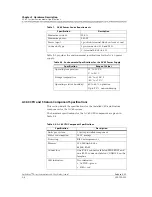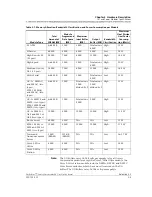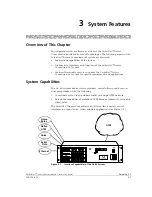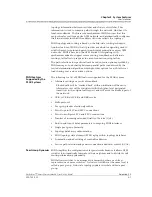
Chapter 3 System Features
Network Management
3-10
255-700-025
PacketStar
™
Access Concentrator 60 User Guide
, Issue 1
Release 6.3.0
As the simplest option, the CPU module faceplate provides an EIA-232
serial port (RJ-11 connector labeled CONSOLE), to which a PC
workstation or a console monitor, running a standard VT100 terminal
emulator, is connected. The console interface provides access to the
configuration, fault, network data-collection, and security-management
features of the system software.The Access Concentrator system
software lets users perform management tasks using a menu-based
interface.
This port is typically used for local management (using a direct serial
connection), but it can also be used for remote management. Remote
management may be performed overa public switched telephone
network (PSTN) with the use of an external modem, or over an ATM
network with the use of a terminal emulation connection between
Multi-Serial modules. The serial port is also used for the configuration of
internet protocol (IP) parameters which are necessary for IP-based
management.
•
Ethernet interface connection on a local-area network (LAN).
A 10BaseT Ethernet interface (RJ-45 connector labeled ETHERNET) on
the PSAX 1250 and PSAX 2300 CPU module faceplates (and the Front
Panel of the PSAX 20 and AC 60) allows the user to access the MIB,
either using the
AQueView™
application over a LAN or by telneting to
the PSAX system. If a telnet session is used to manage a PSAX device,
then the console interface is displayed (similar to that which is used for
the serial interface, as explained above). Only one person can have
access to the console interface at a time; therefore, direct access using
the serial port precludes telnet access using the Ethernet port.
•
In-band management by using a PVC connection over an ATM wide-area
network (WAN).
The in-band management feature on the CPU module allows a user to
access and manage one or more AC 60 systems (managed targets) via a
single PVC connection from a management workstation (management
host) running an SNMP client over an ATM WAN. This allows for IP-
based functions (e.g., telnet) and SNMP functions (e.g., element and
network management software) to be performed remotely using ATM
virtual circuits which terminate directly within the CPU of a managed
node. The PVC connection is set up using an I/O module with an ATM
cell bearing port (for example, the OC-3c, STM-1, DS1, DS3, E1, and E3
modules). Three basic types of configuration are possible:
a. Direct connection from a management host over an ATM WAN to an
I/O module port in a remote managed target.
b. Routed connection from the management host over an ATM WAN
to an I/O module port in a remote Access Concentrator chassis,
which serves as a “router Access Concentrator,” with a connection to
the managed target.
This route connection allows you to flexibly manage any number of Access
Concentrator systems.
















































